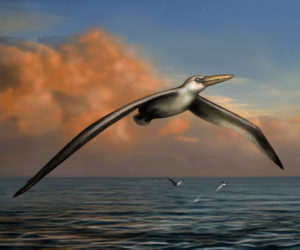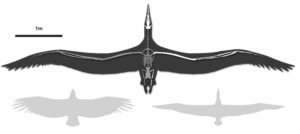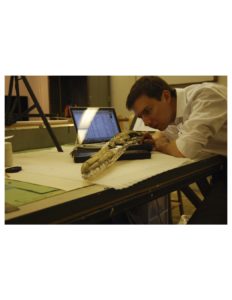 Dr. Ksepka’s topic, “Flight of the World’s Largest Bird” will detail the discovery, reconstruction and computer modeling of flight style in Pelagornis sandersi, an extinct bird he described in 2014. This species had a wing span of approximately 20 feet, making it the largest flying bird that ever lived. He studied the fossil, unearthed in Charleston SC, while he was a fellow at NESCent (a research center on Duke campus) in NC.
Dr. Ksepka’s topic, “Flight of the World’s Largest Bird” will detail the discovery, reconstruction and computer modeling of flight style in Pelagornis sandersi, an extinct bird he described in 2014. This species had a wing span of approximately 20 feet, making it the largest flying bird that ever lived. He studied the fossil, unearthed in Charleston SC, while he was a fellow at NESCent (a research center on Duke campus) in NC.
There is a life-size model of the bird in the Bruce Museum’s rotunda at the moment, on loan from the Smithsonian.
To get an idea how large this bird was, compare the drawing below to California Condor, below left, and the Wandering Albatross, below right.

 Dr. Daniel T. Ksepka, Ph.D., Curator Bruce Museum
Dr. Daniel T. Ksepka, Ph.D., Curator Bruce Museum
Museums are my home, and I am broadly interested in building natural history collections, museum-based outreach and education, and presenting compelling topics in exhibitions. My research centers on the evolution of birds, with particular interests in phylogeny, divergence dating, and the transition to wing-propelled diving in penguins.
Current Research Projects
- Modeling the flight patterns of the largest flying bird ever to have lived, Pelagornis sandersi.
- Reconstructing patterns of brain size expansion in dinosaurs and birds. This project was initiated during a Catalysis Meeting funded by NESCent (NSF EF 0905606) titled “A Deeper Look into the Avian Brian: Using Modern Imaging to Unlock Ancient Endocasts”, with Amy Balanoff and N. Adam Smith.
- Inferring phylogeny and patterns of morphological change in the best group of birds: penguins!This research is currently funded by NSF award DEB: 1556615 “Collaborative Research: Advancing Bayesian Phylogenetic Methods for Synthesizing Paleontological and Neontological Data” with Tracy Heath and Rob Meredith.
- Assembling a full species level tree for all 10,000+ species of birds. As a paleontologist I am particularly interested in using fossil data to accurately reconstruct the timing of the modern bird radiation in order to better understand how events like extinctions, climate change, and plate tectonic events influenced avian evolution.This research is currently funded by NSF award DEB 1655736 “All Birds: A Time-scaled Avian Tree from Integrated Phylogenomic and Fossil Data” with Brian Smith, F. Keith Barker, Edward Braun, Robb Brumfield, Terry Chesser, Brant Faircloth, Rebecca Kimball.
Education
- PhD, Columbia University (2007)
- MS, Columbia University (2005)
- BS, Rutgers University (2002)
Arranged by Robin & Charles Salmans
Here is his presentation: Pelagornis
Dr. Ksepka recommended these two sites:
